Deciphering the Binding Interactions between Acinetobacter baumannii ACP and β-ketoacyl ACP Synthase III to Improve Antibiotic Targeting Using NMR Spectroscopy
Abstract
1. Introduction
2. Results
2.1. Comparison of Pathogenic ACP Sequences
2.2. Solution Structure of AbACP
2.3. Thermal Stability of AbACP and the Effect of Metal on Its Stability
2.4. Backbone Dynamics of AbACP
2.5. Mapping the Binding Residues of AbACP to AbKAS III by Chemical Shift Perturbation
2.6. Binding Model of AbACP to AbKAS III
3. Discussion
4. Materials and Methods
4.1. Cloning, Expression and Purification of AbACP and AbKAS III
4.2. Circular Dichroism (CD) Experiments
4.3. NMR Experiments and Assignments
4.4. Structure Calculation
4.5. Spin-Relaxation Experiments
4.6. Measurement of Chemical Shift Perturbations in the 1H-15N HSQC-TROSY
4.7. Molecular Docking Simulation
5. Conclusions
Supplementary Materials
Author Contributions
Funding
Conflicts of Interest
References
- Pendleton, J.N.; Gorman, S.P.; Gilmore, B.F. Clinical relevance of the ESKAPE pathogens. Expert Rev. Anti. Infect. Ther. 2013, 11, 297–308. [Google Scholar] [CrossRef]
- Rice, L.B. Progress and challenges in implementing the research on ESKAPE pathogens. Infect. Control Hosp. Epidemiol. 2010, 31 (Suppl 1), S7–S10. [Google Scholar] [CrossRef]
- Howard, A.; O’Donoghue, M.; Feeney, A.; Sleator, R.D. Acinetobacter baumannii: An emerging opportunistic pathogen. Virulence 2012, 3, 243–250. [Google Scholar] [CrossRef] [PubMed]
- Bassetti, M.; Righi, E.; Esposito, S.; Petrosillo, N.; Nicolini, L. Drug treatment for multidrug-resistant Acinetobacter baumannii infections. Future Microbiol. 2008, 3, 649–660. [Google Scholar] [CrossRef] [PubMed]
- Pissuwan, D.; Cortie, C.H.; Valenzuela, S.M.; Cortie, M.B. Functionalised gold nanoparticles for controlling pathogenic bacteria. Trends Biotechnol. 2010, 28, 207–213. [Google Scholar] [CrossRef] [PubMed]
- McConnell, M.J.; Dominguez-Herrera, J.; Smani, Y.; Lopez-Rojas, R.; Docobo-Perez, F.; Pachon, J. Vaccination with outer membrane complexes elicits rapid protective immunity to multidrug-resistant Acinetobacter baumannii. Infect. Immun. 2011, 79, 518–526. [Google Scholar] [CrossRef]
- Poole, K. Overcoming multidrug resistance in gram-negative bacteria. Curr. Opin. Investig. Drugs 2003, 4, 128–139. [Google Scholar]
- Aubert, G.; Guichard, D.; Vedel, G. In-vitro activity of cephalosporins alone and combined with sulbactam against various strains of Acinetobacter baumannii with different antibiotic resistance profiles. J. Antimicrob. Chemother. 1996, 37, 155–160. [Google Scholar] [CrossRef][Green Version]
- Bergogne-Berezin, E.; Towner, K.J. Acinetobacter spp. as nosocomial pathogens: Microbiological, clinical, and epidemiological features. Clin. Microbiol. Rev. 1996, 9, 148–165. [Google Scholar] [CrossRef] [PubMed]
- Hsueh, P.R.; Teng, L.J.; Chen, C.Y.; Chen, W.H.; Yu, C.J.; Ho, S.W.; Luh, K.T. Pandrug-resistant Acinetobacter baumannii causing nosocomial infections in a university hospital, Taiwan. Emerg Infect. Dis. 2002, 8, 827–832. [Google Scholar] [CrossRef]
- Wakil, S.J.; Stoops, J.K.; Joshi, V.C. Fatty acid synthesis and its regulation. Annu. Rev. Biochem. 1983, 52, 537–579. [Google Scholar] [CrossRef]
- Chan, D.I.; Vogel, H.J. Current understanding of fatty acid biosynthesis and the acyl carrier protein. Biochem. J. 2010, 430, 1–19. [Google Scholar] [CrossRef]
- White, S.W.; Zheng, J.; Zhang, Y.M. Rock, The structural biology of type II fatty acid biosynthesis. Annu. Rev. Biochem. 2005, 74, 791–831. [Google Scholar] [CrossRef]
- Lee, J.Y.; Jeong, K.W.; Lee, J.U.; Kang, D.I.; Kim, Y. Novel E. coli beta-ketoacyl-acyl carrier protein synthase III inhibitors as targeted antibiotics. Bioorg. Med. Chem. 2009, 17, 1506–1513. [Google Scholar] [CrossRef] [PubMed]
- Lee, J.Y.; Jeong, K.W.; Shin, S.; Lee, J.U.; Kim, Y. Discovery of novel selective inhibitors of Staphylococcus aureus beta-ketoacyl acyl carrier protein synthase III. Eur. J. Med. Chem. 2012, 47, 261–269. [Google Scholar] [CrossRef] [PubMed]
- Lee, W.C.; Park, J.; Balasubramanian, P.K.; Kim, Y. Elucidation of the crystal structure of FabD from the multidrug-resistant bacterium Acinetobacter baumannii. Biochem. Biophys. Res. Commun. 2018, 505, 208–214. [Google Scholar] [CrossRef] [PubMed]
- Lee, W.C.; Jeong, M.C.; Lee, Y.; Kwak, C.; Lee, J.Y.; Kim, Y. Structure and substrate specificity of beta-ketoacyl-acyl carrier protein synthase III from Acinetobacter baumannii. Mol. Microbiol. 2018, 108, 567–577. [Google Scholar] [CrossRef]
- Lee, J.Y.; Jeong, M.C.; Jeon, D.; Lee, Y.; Lee, W.C.; Kim, Y. Structure-activity relationship-based screening of antibiotics against Gram-negative Acinetobacter baumannii. Bioorg. Med. Chem. 2017, 25, 372–380. [Google Scholar] [CrossRef]
- Ha, Y.; Jang, M.; Lee, S.; Lee, J.Y.; Lee, W.C.; Bae, S.; Kang, J.; Han, M.; Kim, Y. Identification of inhibitor binding hotspots in Acinetobacter baumannii beta-ketoacyl acyl carrier protein synthase III using molecular dynamics simulation. J. Mol. Graph. Model. 2020, 100, 107669. [Google Scholar] [CrossRef]
- Chan, D.I.; Stockner, T.; Tieleman, D.P.; Vogel, H.J. Molecular dynamics simulations of the Apo-, Holo-, and acyl-forms of Escherichia coli acyl carrier protein. J. Biol. Chem. 2008, 283, 33620–33629. [Google Scholar] [CrossRef]
- Crosby, J.; Byrom, K.J.; Hitchman, T.S.; Cox, R.J.; Crump, M.P.; Findlow, I.S.; Bibb, M.J.; Simpson, T.J. Acylation of Streptomyces type II polyketide synthase acyl carrier proteins. FEBS Lett. 1998, 433, 132–138. [Google Scholar] [CrossRef][Green Version]
- Mofid, M.R.; Finking, R.; Marahiel, M.A. Recognition of hybrid peptidyl carrier proteins/acyl carrier proteins in nonribosomal peptide synthetase modules by the 4′-phosphopantetheinyl transferases AcpS and Sfp. J. Biol. Chem. 2002, 277, 17023–17031. [Google Scholar] [CrossRef]
- Nguyen, C.; Haushalter, R.W.; Lee, D.J.; Markwick, P.R.; Bruegger, J.; Caldara-Festin, G.; Finzel, K.; Jackson, D.R.; Ishikawa, F.; O’Dowd, B.; et al. Trapping the dynamic acyl carrier protein in fatty acid biosynthesis. Nature 2014, 505, 427–431. [Google Scholar] [CrossRef]
- Majerus, P.W.; Alberts, A.W.; Vagelos, P.R. Acyl Carrier Protein. Iv. The Identification of 4′-Phosphopantetheine as the Prosthetic Group of the Acyl Carrier Protein. Proc. Natl. Acad. Sci. USA 1965, 53, 410–417. [Google Scholar] [CrossRef]
- Zhang, Y.M.; Marrakchi, H.; White, S.W.; Rock, C.O. The application of computational methods to explore the diversity and structure of bacterial fatty acid synthase. J. Lipid. Res. 2003, 44, 1–10. [Google Scholar] [CrossRef]
- Holak, T.A.; Kearsley, S.K.; Kim, Y.; Prestegard, J.H. Three-dimensional structure of acyl carrier protein determined by NMR pseudoenergy and distance geometry calculations. Biochemistry 1988, 27, 6135–6142. [Google Scholar] [CrossRef]
- Kim, Y.; Prestegard, J.H. A dynamic model for the structure of acyl carrier protein in solution. Biochemistry 1989, 28, 8792–8797. [Google Scholar] [CrossRef]
- Wu, B.N.; Zhang, Y.M.; Rock, C.O.; Zheng, J.J. Structural modification of acyl carrier protein by butyryl group. Protein Sci. 2009, 18, 240–246. [Google Scholar] [CrossRef] [PubMed]
- Chan, D.I.; Chu, B.C.; Lau, C.K.; Hunter, H.N.; Byers, D.M.; Vogel, H.J. NMR solution structure and biophysical characterization of Vibrio harveyi acyl carrier protein A75H: Effects of divalent metal ions. J. Biol. Chem. 2010, 285, 30558–30566. [Google Scholar] [CrossRef] [PubMed]
- Barnwal, R.P.; Kaur, M.; Heckert, A.; Gartia, J.; Varani, G. Comparative structure, dynamics and evolution of acyl-carrier proteins from Borrelia burgdorferi, Brucella melitensis and Rickettsia prowazekii. Biochem. J. 2020, 477, 491–508. [Google Scholar] [CrossRef]
- Park, Y.G.; Jung, M.C.; Song, H.; Jeong, K.W.; Bang, E.; Hwang, G.S.; Kim, Y. Novel Structural Components Contribute to the High Thermal Stability of Acyl Carrier Protein from Enterococcus faecalis. J. Biol. Chem. 2016, 291, 1692–1702. [Google Scholar] [CrossRef] [PubMed]
- Lee, Y.; Jang, A.; Jeong, M.C.; Park, N.; Park, J.; Lee, W.C.; Cheong, C.; Kim, Y. Structural Characterization of an ACP from Thermotoga maritima: Insights into Hyperthermal Adaptation. Int. J. Mol. Sci. 2020, 21, 2600. [Google Scholar] [CrossRef]
- Lee, W.; Stark, J.L.; Markley, J.L. PONDEROSA-C/S: Client-server based software package for automated protein 3D structure determination. J. Biomol. NMR 2014, 60, 73–75. [Google Scholar] [CrossRef] [PubMed]
- Bhattacharya, A.; Tejero, R.; Montelione, G.T. Evaluating protein structures determined by structural genomics consortia. Proteins 2007, 66, 778–795. [Google Scholar] [CrossRef]
- Lee, W.; Cornilescu, G.; Dashti, H.; Eghbalnia, H.R.; Tonelli, M.; Westler, W.M.; Butcher, S.E.; Henzler-Wildman, K.A.; Markley, J.L. Integrative NMR for biomolecular research. J. Biomol. NMR 2016, 64, 307–332. [Google Scholar] [CrossRef]
- Zhang, Y.M.; Rao, M.S.; Heath, R.J.; Price, A.C.; Olson, A.J.; Rock, C.O.; White, S.W. Identification and analysis of the acyl carrier protein (ACP) docking site on beta-ketoacyl-ACP synthase III. J. Biol. Chem. 2001, 276, 8231–8238. [Google Scholar] [CrossRef]
- Kim, Y.; Kovrigin, E.L.; Eletr, Z. NMR studies of Escherichia coli acyl carrier protein: Dynamic and structural differences of the apo- and holo-forms. Biochem. Biophys. Res. Commun. 2006, 341, 776–783. [Google Scholar] [CrossRef]
- Zornetzer, G.A.; Fox, B.G.; Markley, J.L. Solution structures of spinach acyl carrier protein with decanoate and stearate. Biochemistry 2006, 45, 5217–5227. [Google Scholar] [CrossRef]
- Kovermann, M.; Rogne, P.; Wolf-Watz, M. Protein dynamics and function from solution state NMR spectroscopy. Q. Rev. Biophys. 2016, 49, e6. [Google Scholar] [CrossRef] [PubMed]
- Millet, O.; Loria, J.P.; Kroenke, C.D.; Pons, M.; Palmer, A.G. The static magnetic field dependence of chemical exchange linebroadening defines the NMR chemical shift time scale. J. Am. Chem. Soc. 2000, 122, 2867–2877. [Google Scholar] [CrossRef]
- Beld, J.; Cang, H.; Burkart, M.D. Visualizing the chain-flipping mechanism in fatty-acid biosynthesis. Angew. Chem. Int. Ed. Engl. 2014, 53, 14456–14461. [Google Scholar] [CrossRef]
- Cronan, J.E. The chain-flipping mechanism of ACP (acyl carrier protein)-dependent enzymes appears universal. Biochem. J. 2014, 460, 157–163. [Google Scholar] [CrossRef]
- Williamson, M.P. Using chemical shift perturbation to characterise ligand binding. Prog. Nucl. Magn. Reson. Spectrosc. 2013, 73, 1–16. [Google Scholar] [CrossRef] [PubMed]
- Davies, C.; Heath, R.J.; White, S.W.; Rock, C.O. The 1.8 A crystal structure and active-site architecture of beta-ketoacyl-acyl carrier protein synthase III (FabH) from escherichia coli. Structure 2000, 8, 185–195. [Google Scholar] [CrossRef]
- Ashkenazy, H.; Abadi, S.; Martz, E.; Chay, O.; Mayrose, I.; Pupko, T.; Ben-Tal, N. ConSurf 2016: An improved methodology to estimate and visualize evolutionary conservation in macromolecules. Nucleic Acids Res. 2016, 44, W344–W350. [Google Scholar] [CrossRef]
- Yuan, Y.; Leeds, J.A.; Meredith, T.C. Pseudomonas aeruginosa directly shunts beta-oxidation degradation intermediates into de novo fatty acid biosynthesis. J. Bacteriol. 2012, 194, 5185–5196. [Google Scholar] [CrossRef] [PubMed]
- Chen, A.; Re, R.N.; Burkart, M.D. Type II fatty acid and polyketide synthases: Deciphering protein-protein and protein-substrate interactions. Nat. Prod. Rep. 2018, 35, 1029–1045. [Google Scholar] [CrossRef]
- Milligan, J.C.; Lee, D.J.; Jackson, D.R.; Schaub, A.J.; Beld, J.; Barajas, J.F.; Hale, J.J.; Luo, R.; Burkart, M.D.; Tsai, S.C. Molecular basis for interactions between an acyl carrier protein and a ketosynthase. Nat. Chem. Biol. 2019, 15, 669–671. [Google Scholar] [CrossRef] [PubMed]
- Mindrebo, J.T.; Misson, L.E.; Johnson, C.; Noel, J.P.; Burkart, M.D. Activity Mapping the Acyl Carrier Protein: Elongating Ketosynthase Interaction in Fatty Acid Biosynthesis. Biochemistry 2020, 59, 3626–3638. [Google Scholar] [CrossRef] [PubMed]
- Mindrebo, J.T.; Patel, A.; Kim, W.E.; Davis, T.D.; Chen, A.; Bartholow, T.G.; La Clair, J.J.; McCammon, J.A.; Noel, J.P.; Burkart, M.D. Gating mechanism of elongating beta-ketoacyl-ACP synthases. Nat. Commun. 2020, 11, 1727. [Google Scholar] [CrossRef] [PubMed]
- Misson, L.E.; Mindrebo, J.T.; Davis, T.D.; Patel, A.; McCammon, J.A.; Noel, J.P.; Burkart, M.D. Interfacial plasticity facilitates high reaction rate of E. coli FAS malonyl-CoA:ACP transacylase, FabD. Proc. Natl. Acad Sci. USA 2020, 117, 24224–24233. [Google Scholar] [CrossRef]
- Delaglio, F.; Grzesiek, S.; Vuister, G.W.; Zhu, G.; Pfeifer, J.; Bax, A. NMRPipe: A multidimensional spectral processing system based on UNIX pipes. J. Biomol. NMR 1995, 6, 277–293. [Google Scholar] [CrossRef] [PubMed]
- Lee, W.; Tonelli, M.; Markley, J.L. NMRFAM-SPARKY: Enhanced software for biomolecular NMR spectroscopy. Bioinformatics 2015, 31, 1325–1327. [Google Scholar] [CrossRef] [PubMed]
- Park, J.; Lee, Y.; Cheon, D.; Kim, Y. Structure and dynamics of human and bacterial acyl carrier proteins and their interactions with fatty acid synthesis proteins. Biochem. Biophys. Res. Commun. 2019, 516, 1183–1189. [Google Scholar] [CrossRef] [PubMed]
- Morris, G.M.; Goodsell, D.S.; Halliday, R.S.; Huey, R.; Hart, W.E.; Belew, R.K.; Olson, A.J. Automated docking using a Lamarckian genetic algorithm and an empirical binding free energy function. J. Comput. Chem. 1998, 19, 1639–1662. [Google Scholar] [CrossRef]

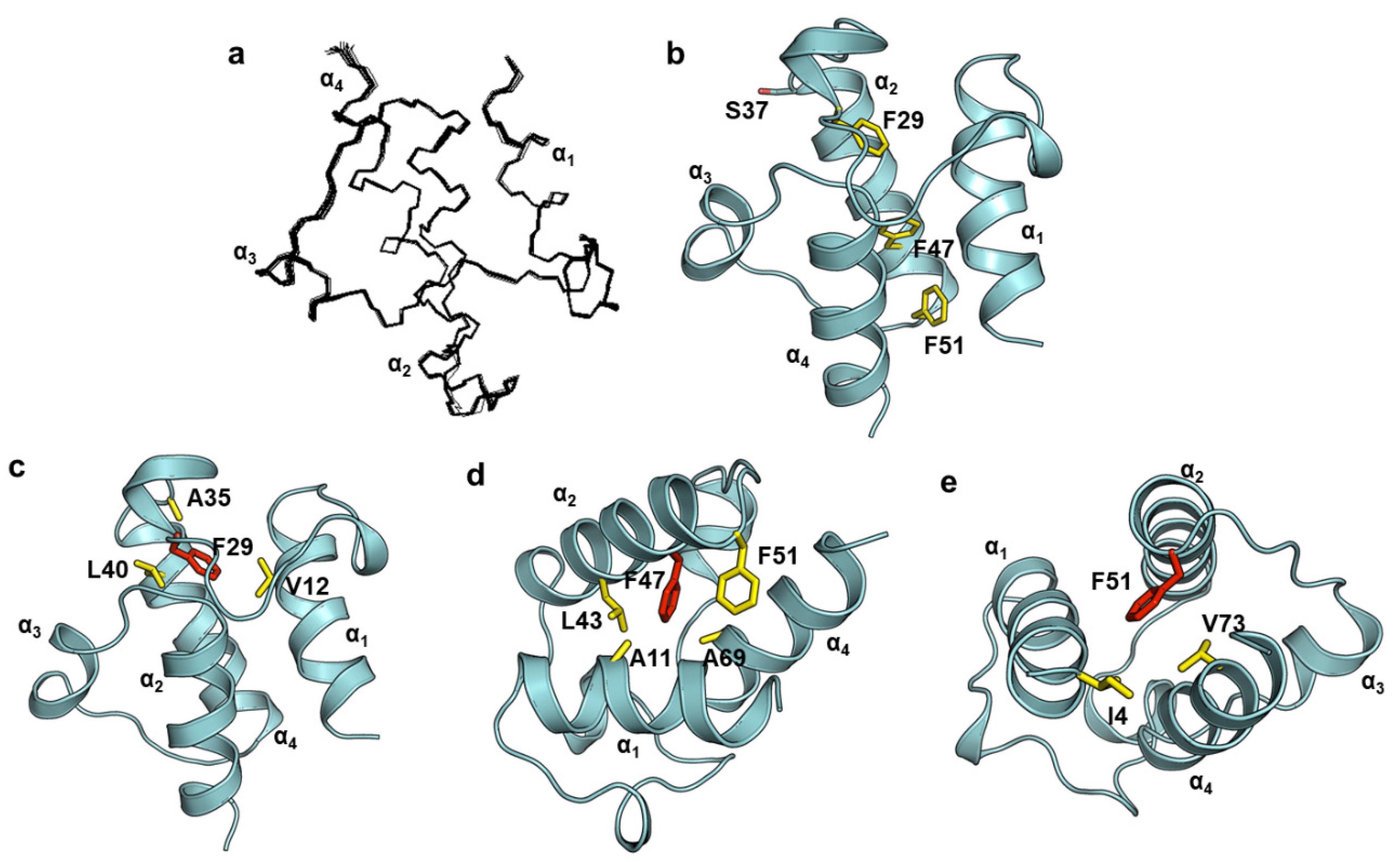
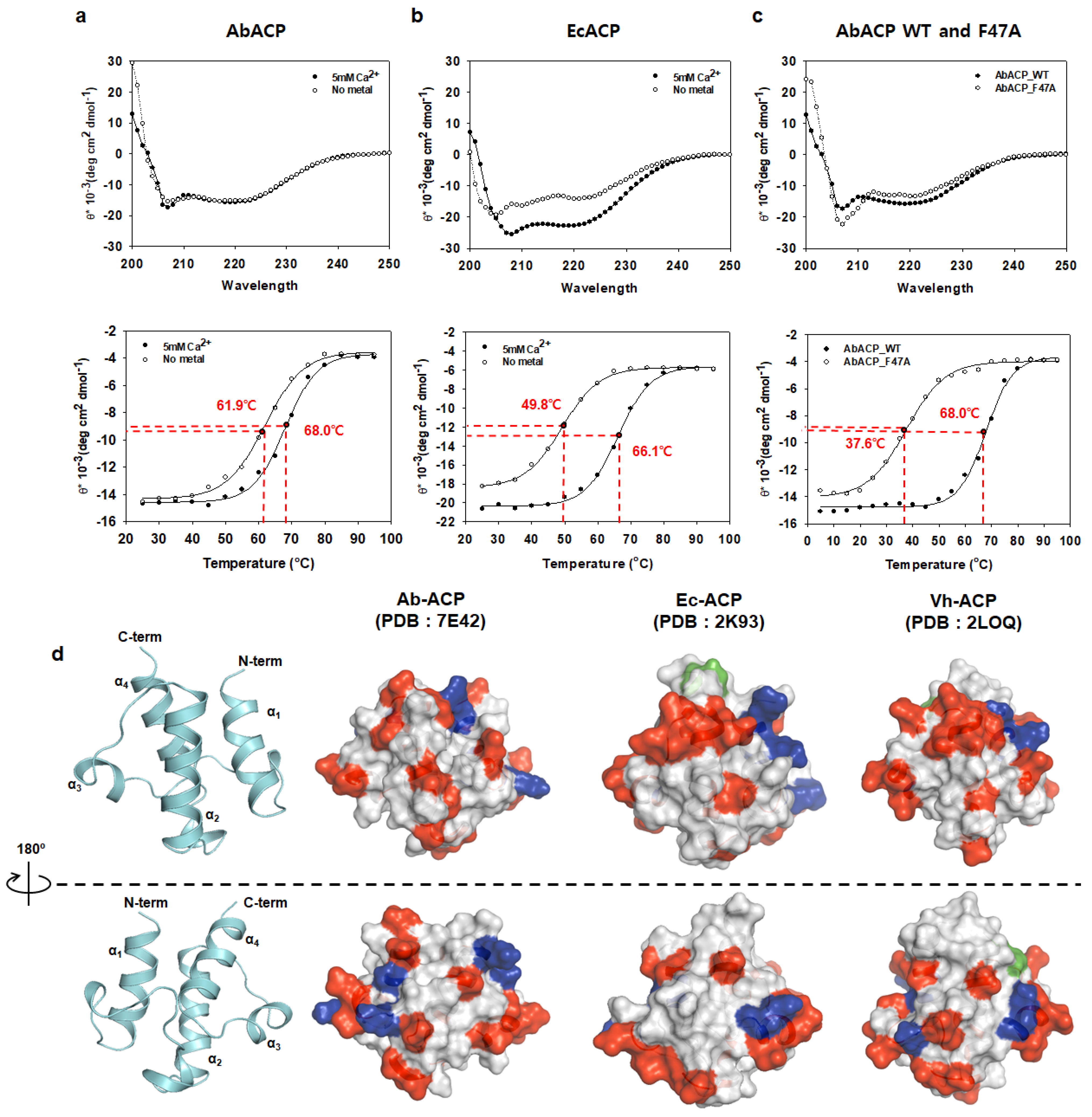
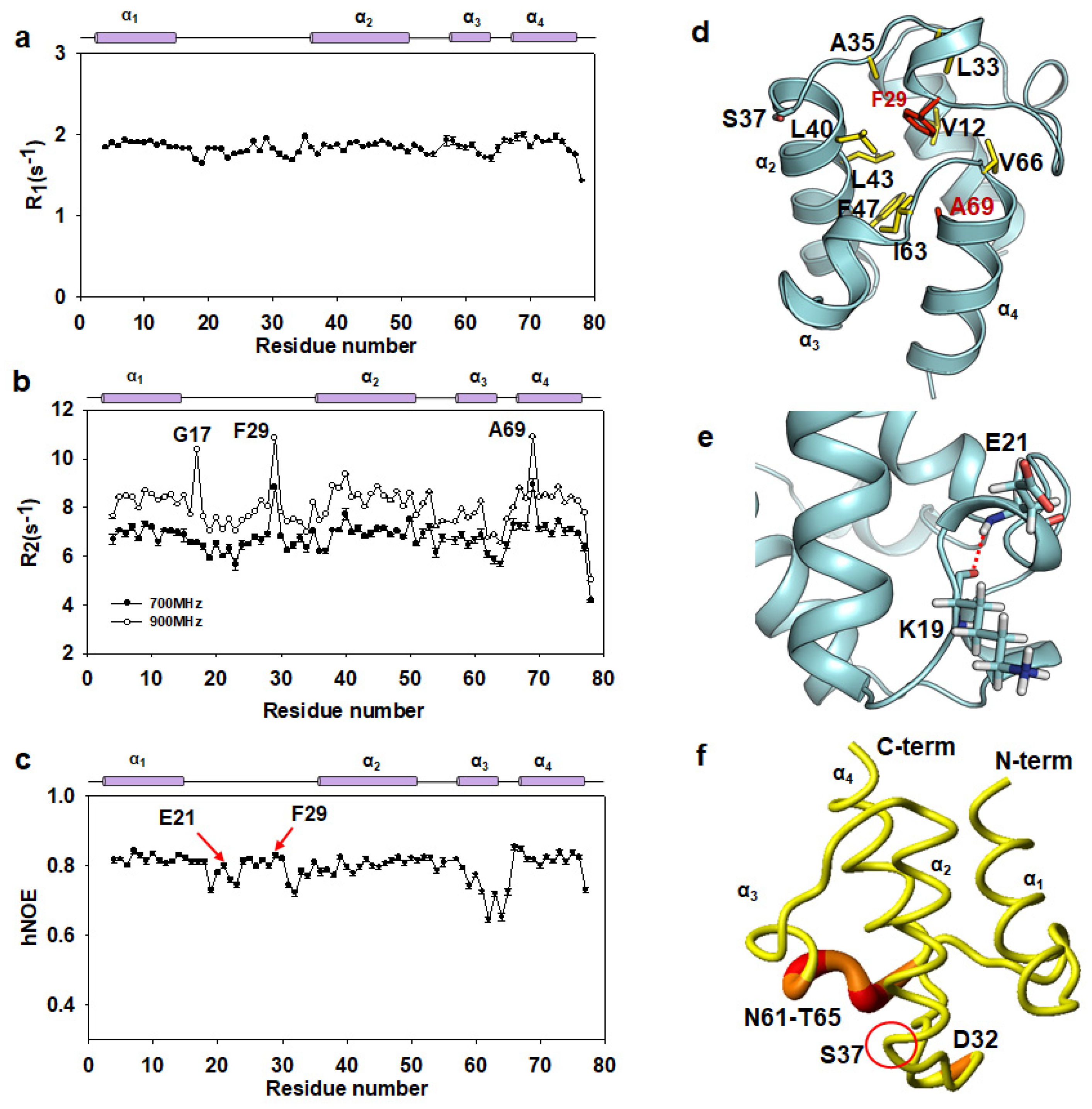
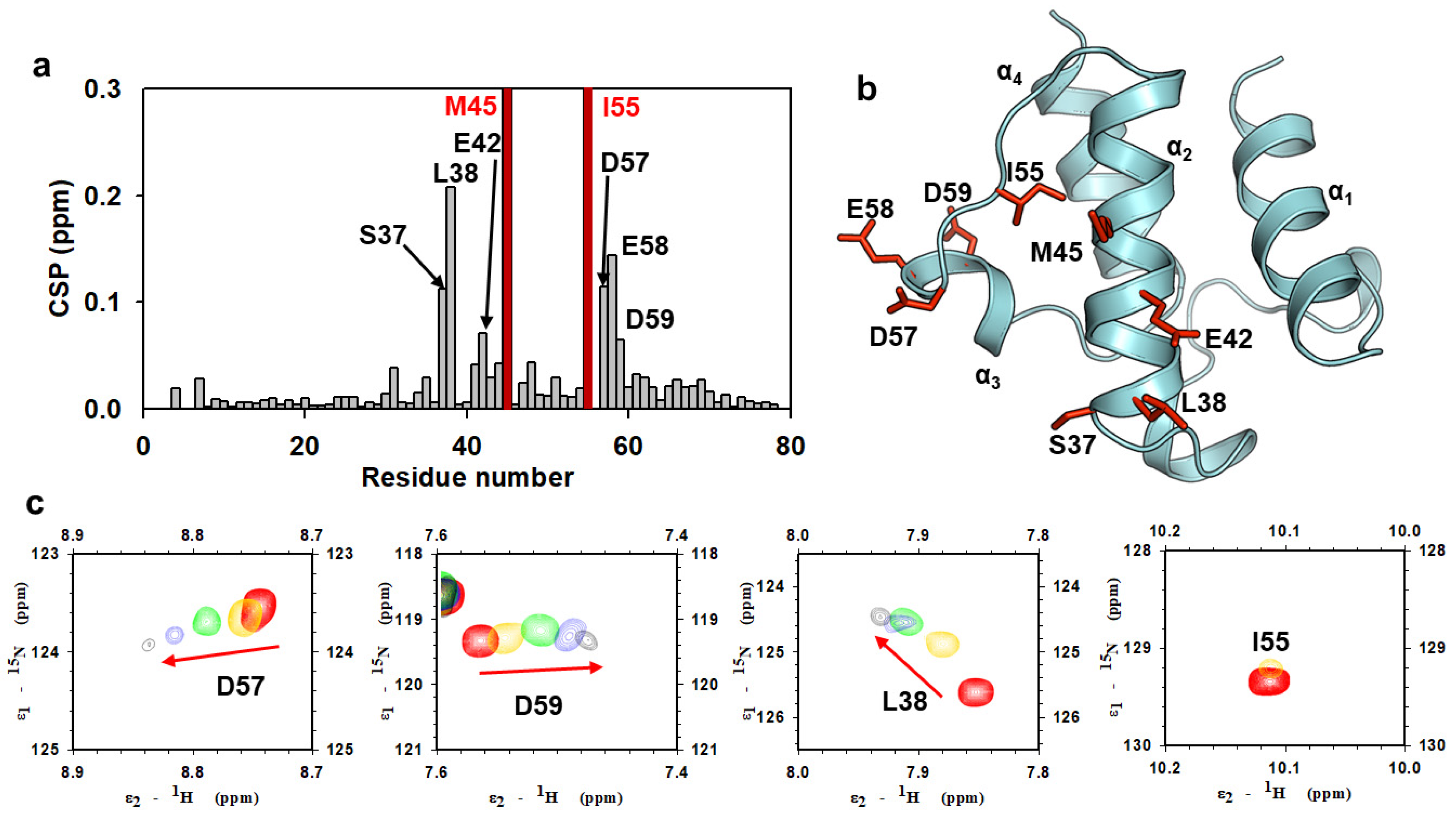
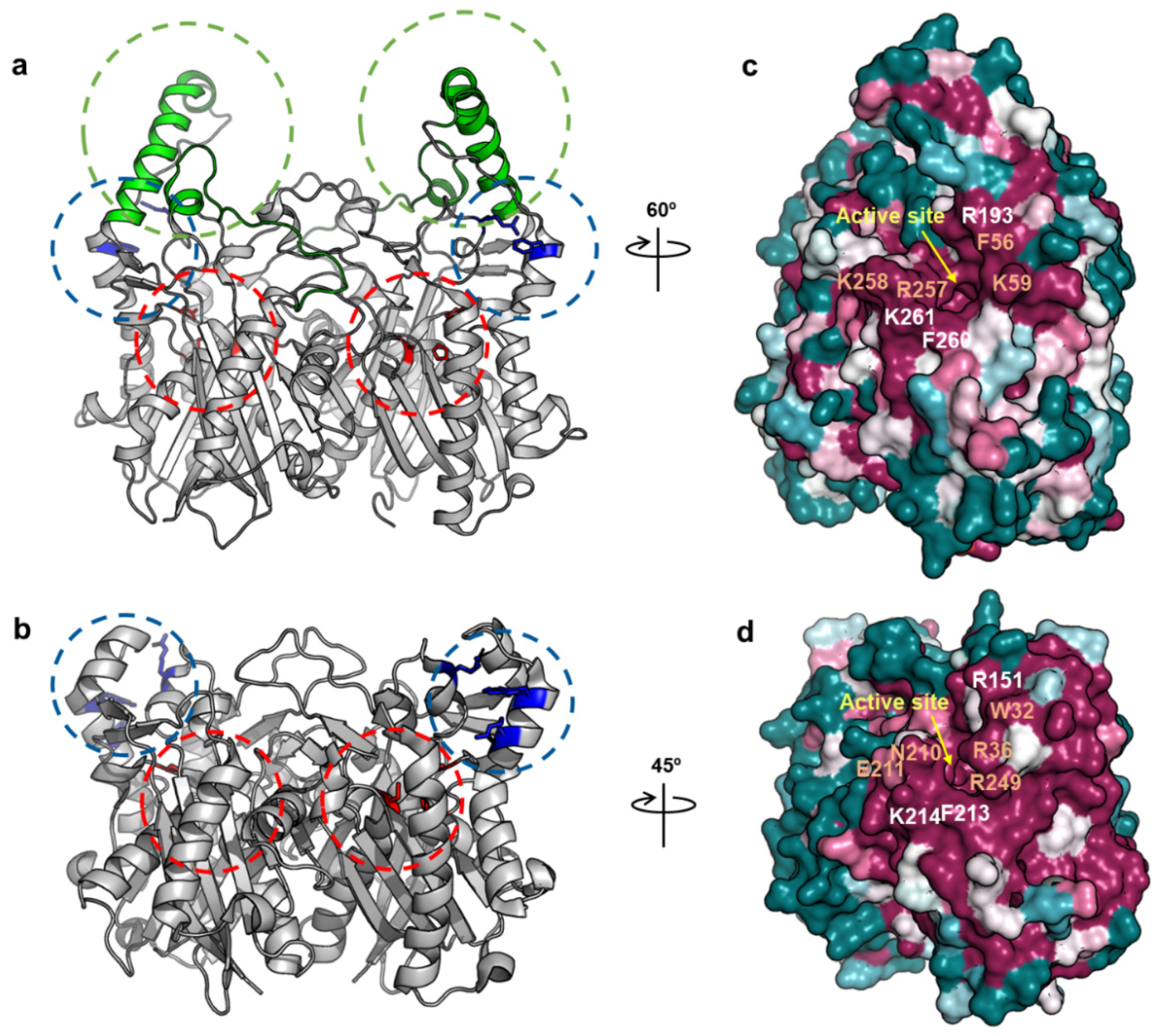
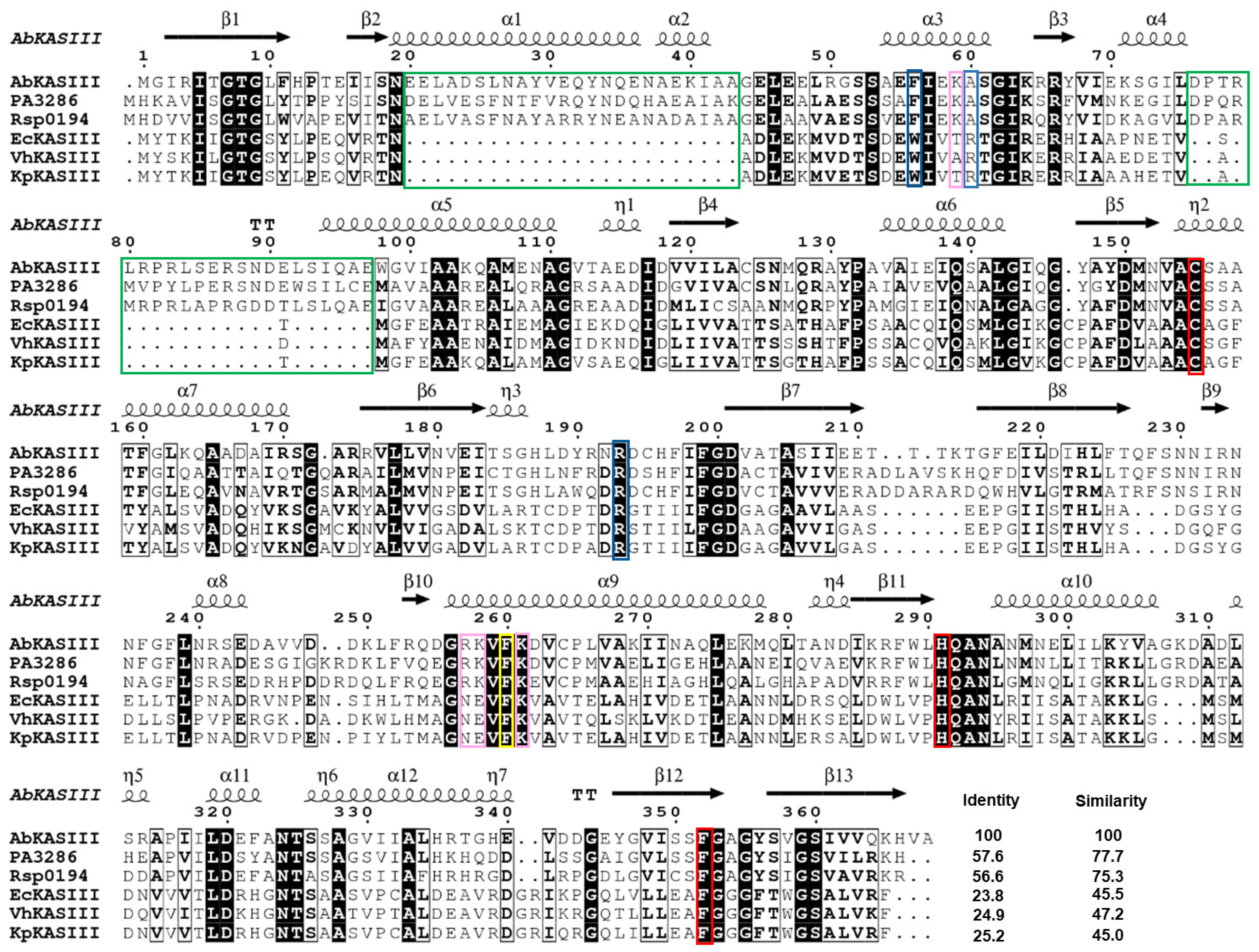

| Restraints a | |
|---|---|
| Total | 1465 |
| Conformationally restricting distance constraints | |
| Short Range [(i − j) ≤ 1] | 157 |
| Medium Range [1 < (i − j) ≤ 5]1 | 573 |
| Long Range [(i − j) ≥ 5] | 446 |
| Dihedral angle constraints | |
| Phi | 71 |
| Psi | 70 |
| Residual dipolar coupling constraints | 74 |
| Hydrogen bond constraints | 74 |
| Average RMSD (Root Mean Square Deviation)to the Mean Xplor-NIH Coordinates (Å) b | |
| Backbone atoms (all residues/order residues) c Heavy atoms (all residues/order residues) c | 0.1/0.1 |
| 0.4/0.4 | |
| Summary of Ramachandran Plot from PROCHECK (%) b | |
| Most favored regions | 97.6 |
| Additionally allowed regions | 2.4 |
| Generously allowed regions | 0 |
| Dis-allowed regions | 0 |
| Average Number of Violations per Xplor-NIH Conformer d | |
| Distance constraint violations (>0.2 Å) | 0 |
| Angle constraint violations (>10°) | 0 |
Publisher’s Note: MDPI stays neutral with regard to jurisdictional claims in published maps and institutional affiliations. |
© 2021 by the authors. Licensee MDPI, Basel, Switzerland. This article is an open access article distributed under the terms and conditions of the Creative Commons Attribution (CC BY) license (http://creativecommons.org/licenses/by/4.0/).
Share and Cite
Choi, S.; Park, J.; Yeon, J.; Jang, A.; Lee, W.C.; Kim, Y. Deciphering the Binding Interactions between Acinetobacter baumannii ACP and β-ketoacyl ACP Synthase III to Improve Antibiotic Targeting Using NMR Spectroscopy. Int. J. Mol. Sci. 2021, 22, 3317. https://doi.org/10.3390/ijms22073317
Choi S, Park J, Yeon J, Jang A, Lee WC, Kim Y. Deciphering the Binding Interactions between Acinetobacter baumannii ACP and β-ketoacyl ACP Synthase III to Improve Antibiotic Targeting Using NMR Spectroscopy. International Journal of Molecular Sciences. 2021; 22(7):3317. https://doi.org/10.3390/ijms22073317
Chicago/Turabian StyleChoi, Sungjae, Jungwoo Park, Jiwon Yeon, Ahjin Jang, Woo Cheol Lee, and Yangmee Kim. 2021. "Deciphering the Binding Interactions between Acinetobacter baumannii ACP and β-ketoacyl ACP Synthase III to Improve Antibiotic Targeting Using NMR Spectroscopy" International Journal of Molecular Sciences 22, no. 7: 3317. https://doi.org/10.3390/ijms22073317
APA StyleChoi, S., Park, J., Yeon, J., Jang, A., Lee, W. C., & Kim, Y. (2021). Deciphering the Binding Interactions between Acinetobacter baumannii ACP and β-ketoacyl ACP Synthase III to Improve Antibiotic Targeting Using NMR Spectroscopy. International Journal of Molecular Sciences, 22(7), 3317. https://doi.org/10.3390/ijms22073317







